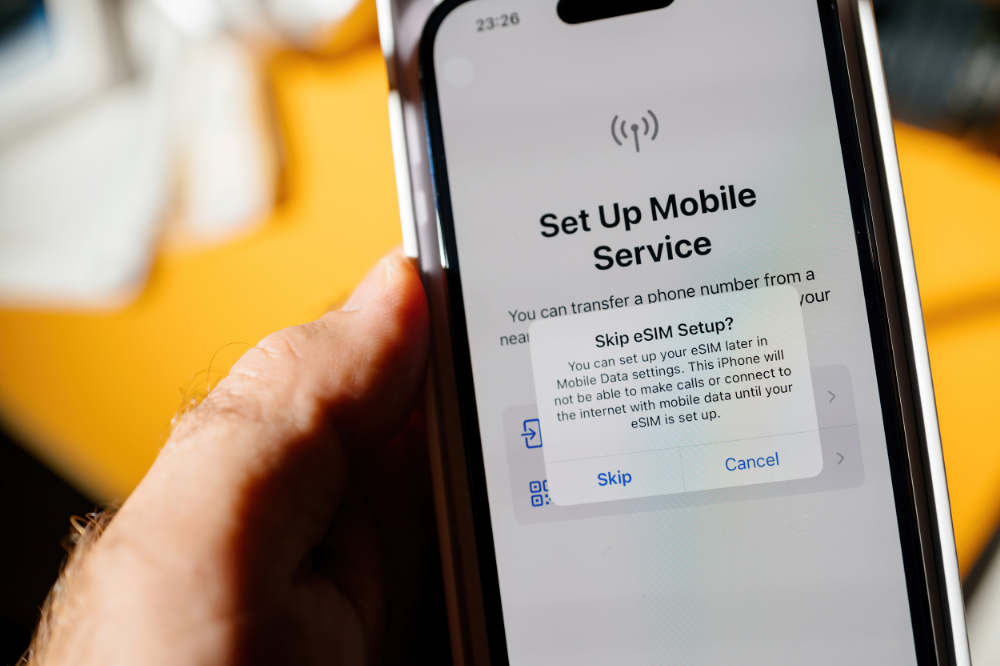Japan eSIM Unlimited Data: The Smartest Internet Option for Travelers in 2025

For many, staying online has become essential, especially when going abroad. Among the numerous available options, eSIMs stand out for their ease of use and fast setup. With no physical device to collect or install, travelers with compatible phones can activate the service before or immediately upon arrival.
Compared to public WiFi, which can be unreliable, or international roaming, which is often costly, unlimited eSIM plans offer a more consistent and efficient way to stay connected in Japan. This guide outlines how they work, what to consider when choosing a plan, and how they compare with pocket WiFi and SIM cards.
What is a Japan eSIM with Unlimited Data and Why Travelers Love It
An eSIM with unlimited data quickly becomes the preferred choice for travelers who value convenience and constant connectivity. It simplifies mobile access in Japan, allowing for smooth navigation, communication, and sharing.
How a Japan eSIM with Unlimited Data Works
An eSIM (embedded SIM) is a digital alternative to a physical SIM card. Built directly into many modern smartphones, it enables users to remotely install a mobile data plan without needing to handle any hardware. An eSIM provides a convenient way for travelers to Japan to connect to local mobile networks immediately upon arrival.
Unlike physical SIM cards, which require in-person pickup or delivery, or pocket WiFi devices that must be carried and later returned, an eSIM can be activated in advance or on the spot using a QR code or mobile app.
Devices compatible with Japan eSIMs include recent models of the iPhone (XS and later), Google Pixel (Pixel 3 and later), certain Samsung Galaxy phones, and models from Huawei, Motorola, Oppo, Sony, Xiaomi, and other manufacturers.
Benefits of an Unlimited eSIM for Japan
Unlimited eSIM plans offer several practical advantages. Activation is typically instant, eliminating the need to queue at airport counters or rental kiosks. There is no extra device to carry, charge, or return, reducing the risk of loss.
Unlimited data provides uninterrupted access to essential tools, such as Google Maps, Instagram, and live translation apps, for both short-term and long-term tourists.
Travelers can easily post photos, message contacts, and check transit schedules in real time.
Downsides to Consider Before Choosing an eSIM
It is important to note that not all smartphones support eSIM technology; travelers using older models may need to rely on traditional SIM cards or pocket WiFi instead.
Besides, connection quality can vary based on the mobile network used by the eSIM provider. While many providers connect through major Japanese carriers, network performance may differ depending on location, especially in rural areas.
For those requiring the most stable and high-speed connection throughout Japan, checking network details before purchase is essential.
How to Choose the Best Unlimited Data Plan for Japan

Selecting the best unlimited eSIM for Japan depends on several practical factors, including the length of your stay and the amount of data you’ll realistically need each day.
While many plans are marketed as “unlimited,” not all offer the same speeds, coverage, or terms, so careful comparison is essential before making a purchase.
Factors to Consider When Choosing an eSIM for Japan
The right plan starts with your travel duration: short-term visitors may benefit from fixed-day packages, while long-term travelers might prefer flexible monthly plans. Some providers offer 3, 7, or 15-day options ideal for vacations or business trips, while others cater to stays of 30 days or more.
For extended travel, monthly plans often provide better value and more stable data allowances, especially if you need consistent work or remote communication access. Choosing a plan that aligns with your itinerary helps avoid overpaying for unused data or running out midway through your trip.
For a practical balance between data and cost, NINJA WiFi offers eSIM plans for a wide range of travel needs—from 3,102 yen for 5 days with 5GB of data to 18,403 yen for up to 100GB over 31 days. These options enable short-term and extended-stay travelers to select a plan that suits their usage without overspending.
Tips for Getting the Best Deal
It’s always recommended to book your eSIM in advance. It saves time and trouble and often unlocks early-bird discounts or special rates. Some providers also offer bundle deals for multiple devices or longer stays.
Additionally, it is essential to look for providers that offer customer support in English, flexible cancellation policies, and multiple delivery or activation options. These services can help reduce stress, especially when travel plans change unexpectedly.
eSIM With Unlimited 5G Data for Japan: What to Know About Networks and Fair Usage

Not all unlimited eSIM plans are created equal, particularly in terms of speed, coverage, and fair usage policies. Understanding how mobile networks operate in Japan and what providers imply by “unlimited data” can help you choose a plan that supports your travel needs without unexpected slowdowns.
Japan’s Mobile Networks: Docomo, Softbank, and KDDI Comparison
Japan’s three major mobile carriers—Docomo, SoftBank, and KDDI (au)—offer extensive nationwide coverage, but with subtle differences.
- ●Docomo is known for its extensive 4G coverage, providing the broadest rural coverage and strong overall reliability, making it a solid choice for travelers exploring areas outside major cities.
- ●SoftBank tends to excel in urban areas with fast data speeds, but may offer slightly less consistent service in remote regions.
- ●KDDI (au) offers a nationwide 3G/4G network, competitive speeds, and growing 5G access, particularly in metropolitan zones.
-
Most international eSIM providers do not operate their own networks; instead, they lease capacity from one or more of these carriers, which implies that your experience may vary based on the underlying network used by your chosen eSIM provider.
What Unlimited Really Means: Understanding the Fair Usage Policy
While many providers advertise unlimited data, most plans include a daily high-speed data allowance, typically between 2GB and 5GB. Once this limit is reached, your connection speed is throttled, often decreasing to 128–384 Kbps.
Apps such as Google Maps, messaging services, and email remain functional at reduced speeds, though video streaming and large downloads will be slower. Reading the fine print is essential: knowing what happens after you reach your high-speed threshold ensures no surprises, especially if you rely on streaming, cloud uploads, or video conferencing.
5G vs. 4G in Japan for Travelers
Japan’s 5G rollout is ongoing, with strong availability in large cities such as Tokyo, Osaka, and Nagoya.
Travelers using recent devices (iPhone 12 or newer, Pixel 5 or newer, etc.) can often access 5G speeds through compatible eSIMs—but only if the provider supports 5G on Japan’s networks.
However, many international eSIM services still default to 4G LTE connections. Fortunately, Japan’s 4G infrastructure is fast, stable, and more than sufficient for typical traveler needs—including video calls, navigation, social media, and translation apps.
Consistent 4G LTE coverage will be more than adequate for daily use unless you plan to upload large files or stream high-definition video regularly.
Pocket WiFi vs. SIM Card vs. eSIM: What’s Best for Unlimited Data in Japan ?

Selecting the best internet option in Japan depends on your travel habits, the devices you use, and the amount of data you require. While eSIM technology offers speed and convenience, traditional options like pocket WiFi and physical SIM cards still provide value, especially in specific scenarios.
Understanding the trade-offs between each solution can help you stay connected efficiently throughout your trip.
Pros and Cons of Each Option
Pocket WiFi offers reliable, high-speed connectivity that can be shared across multiple devices. It’s convenient for groups or families, and often delivers a stable, secure signal even in areas where mobile reception fluctuates. However, it does require carrying and charging a separate device, and you’ll need to return the unit at the end of your trip.
SIM cards are a good option for solo travelers using unlocked phones. They involve physical swapping, which can be inconvenient for some, and require careful handling. Compatibility with Japanese networks also varies depending on the phone model.
eSIMs provide a lightweight, digital alternative that can be activated before or upon arrival in Japan. There’s no physical component to manage, and setup is typically fast. The downside is that not all smartphones support eSIMs, and the activation process may require using a provider-specific app or scanning a QR code—factors that may not be suitable for every traveler.
When an Unlimited Pocket WiFi Might Be the Better Choice
While eSIMs are gaining popularity, pocket WiFi still holds distinct advantages, particularly for those traveling in groups. A single device can connect multiple smartphones, tablets, or laptops, keeping everyone online without needing separate data plans. Sharing one connection often leads to significant cost savings for families or friends on the go.
Travelers spending extended time in Japan or visiting multiple cities may also benefit from the consistency of a pocket WiFi device. NINJA WiFi, for example, offers broad airport coverage across the country, including pick-up in Sapporo and return in Naha—an advantage for long-term itineraries or regional tours.
Flexible return options, combined with the fact that the device does not need to be returned to the original pick-up point, add to the convenience.
Conclusion
Travelers to Japan today have more connectivity options than ever before—and for many, an eSIM with unlimited data offers the most seamless and practical experience.
With instant activation, no hardware to carry, and full compatibility with essential apps, eSIMs make staying connected throughout your trip remarkably straightforward.
Booking your data plan in advance ensures one less thing to worry about after landing. Providers like NINJA WiFi offer dependable options—whether you're looking for a full-featured eSIM, a traditional SIM card, or a shareable pocket WiFi unit—to help make your time in Japan more comfortable and connected.









